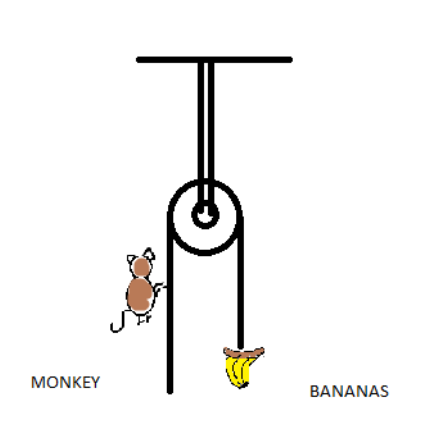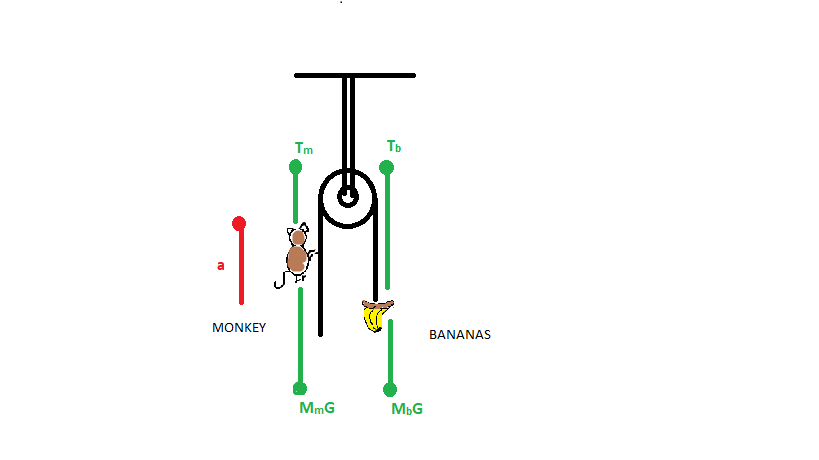
A monkey is at rest on a weightless rope which goes over a pulley and is tied to a bunch of bananas at the other end. The weight of the bunch of bananas is exactly the same as that of the monkey. The pulley is frictionless and weightless. The monkey starts to climb up the rope to reach the bananas. As he climbs, the distance between him and the bananas will:

$\left( {{A}} \right)$ Decrease
$\left( {{B}} \right)$ Increase
$\left( {{C}} \right)$ First decrease and then increase
$\left( {{D}} \right)$ Remain unchanged
Answer
218.4k+ views
Hint: Here, the monkey accelerates upwards, thus the bunch of bananas also accelerates with the same magnitude which is downwards. The mass of the monkey and bananas are the same. The separation between monkey and bananas remains constant. In case the monkey moves upward then \[{{T > MG}}\].
Complete step by step answer:

Let us assume that the monkey is moving upward with direction a. The forces acting on the monkey is \[{{{M}}_{{m}}}{{G}}\] and tension \[{{{T}}_{{m}}}\] because of the rope.
Similarly, the forces acting on the bananas are \[{{{M}}_{{b}}}{{G}}\] and tension \[{{{T}}_{{b}}}\] because of the rope.
So, from the above data the net force in the direction of acceleration a (for monkey) is:
\[\Rightarrow {{T = }}{{{M}}_{{m}}}{{(G + a)}}\]
The net force for bananas is
\[\Rightarrow {{T = M_b G}}\]
Equating both the equations,
\[\Rightarrow {{M_b G = }}{{{M}}_{{m}}}{{(G + a)}}\]
On multiplying the term we get
\[\Rightarrow {{M_b G = }}{{{M}}_{{m}}}{{G + }}{{{M}}_{{m}}}{{a}}\]
According to the question, the mass of the monkey and bananas are the same.
So, \[{{{M}}_{{m}}}{{ = }}{{{M}}_{{b}}}\]
\[\Rightarrow {{M_m a = 0}}\]
\[\Rightarrow {{a = 0}}\].
Therefore, the acceleration \[a\]is zero and the distance between monkey and the banana will remain unchanged.
Hence the correct option is \[D\].
Note: In the above question, bananas are not accelerating in any direction and only the monkey is moving with an acceleration a.
Wrong thinking:
The monkey is moving up by pulling the rope downwards, then the distance between the monkey and bananas will be decreased.
The above one is wrong because the masses of the monkey and bananas are the same as per question.
Complete step by step answer:

Let us assume that the monkey is moving upward with direction a. The forces acting on the monkey is \[{{{M}}_{{m}}}{{G}}\] and tension \[{{{T}}_{{m}}}\] because of the rope.
Similarly, the forces acting on the bananas are \[{{{M}}_{{b}}}{{G}}\] and tension \[{{{T}}_{{b}}}\] because of the rope.
So, from the above data the net force in the direction of acceleration a (for monkey) is:
\[\Rightarrow {{T = }}{{{M}}_{{m}}}{{(G + a)}}\]
The net force for bananas is
\[\Rightarrow {{T = M_b G}}\]
Equating both the equations,
\[\Rightarrow {{M_b G = }}{{{M}}_{{m}}}{{(G + a)}}\]
On multiplying the term we get
\[\Rightarrow {{M_b G = }}{{{M}}_{{m}}}{{G + }}{{{M}}_{{m}}}{{a}}\]
According to the question, the mass of the monkey and bananas are the same.
So, \[{{{M}}_{{m}}}{{ = }}{{{M}}_{{b}}}\]
\[\Rightarrow {{M_m a = 0}}\]
\[\Rightarrow {{a = 0}}\].
Therefore, the acceleration \[a\]is zero and the distance between monkey and the banana will remain unchanged.
Hence the correct option is \[D\].
Note: In the above question, bananas are not accelerating in any direction and only the monkey is moving with an acceleration a.
Wrong thinking:
The monkey is moving up by pulling the rope downwards, then the distance between the monkey and bananas will be decreased.
The above one is wrong because the masses of the monkey and bananas are the same as per question.
Recently Updated Pages
Two discs which are rotating about their respective class 11 physics JEE_Main

A ladder rests against a frictionless vertical wall class 11 physics JEE_Main

Two simple pendulums of lengths 1 m and 16 m respectively class 11 physics JEE_Main

The slopes of isothermal and adiabatic curves are related class 11 physics JEE_Main

A trolly falling freely on an inclined plane as shown class 11 physics JEE_Main

The masses M1 and M2M2 M1 are released from rest Using class 11 physics JEE_Main

Trending doubts
JEE Main 2026: Application Form Open, Exam Dates, Syllabus, Eligibility & Question Papers

Derivation of Equation of Trajectory Explained for Students

Hybridisation in Chemistry – Concept, Types & Applications

Understanding the Angle of Deviation in a Prism

Understanding Collisions: Types and Examples for Students

Understanding Atomic Structure for Beginners

Other Pages
JEE Advanced Marks vs Ranks 2025: Understanding Category-wise Qualifying Marks and Previous Year Cut-offs

Units And Measurements Class 11 Physics Chapter 1 CBSE Notes - 2025-26

NCERT Solutions For Class 11 Physics Chapter 8 Mechanical Properties Of Solids

Motion in a Straight Line Class 11 Physics Chapter 2 CBSE Notes - 2025-26

NCERT Solutions for Class 11 Physics Chapter 7 Gravitation 2025-26

How to Convert a Galvanometer into an Ammeter or Voltmeter




